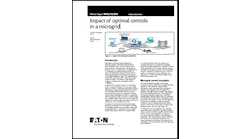In this week’s Industry Perspectives, Scott Manson, of Schweitzer Engineering Laboratories, covers the key factors behind reliable microgrid control system integration.
Making the microgrids of tomorrow as reliable as the conventional macrogrid power systems of today is a significant challenge. Microgrids capable of islanded operation must operate as independent power systems with complex electrical, mechanical, legal, and revenue control systems. For example, successful microgrid implementation requires skills in traditional electric power systems, closed loop control, inverters, electromagnetic transients program (EMTP) modeling, stability studies, protection theory, rotating machinery, dynamics, and code development.
Microgrids capable of islanded operation must operate as independent power systems with complex electrical, mechanical, legal, and revenue control systems.
Scott Manson, SEL Engineering Services technology director at Schweitzer Engineering Laboratories
Thankfully, microgrid designers can leverage a large base of successfully installed projects and products. Every large transport vessel today is a reliable microgrid; think of ships, planes, and automobiles. The power management systems perfected in the oil & gas industry are another example; these are proving to be more reliable than the macrogrids they connect to. Furthermore, hundreds of thousands of microprocessor-based smart-grid protection, control, metering, and security devices are installed throughout our North American grids.
Over the last 15 years, the most successful microgrid projects have been run by passionate, diligent, and skilled engineers who share a focused obsession with perfection. Once the right team and leadership are in place, the next commonality of solid project performance is having well-established procedures, policies, and plans for project execution.
The third ingredient of all successful projects is mature technology. New technology tends to over complicate designs. Elegant, simplified, fit-for-function designs are a sure sign of maturity. Skilled engineering teams are able to configure standard protection and microgrid control system equipment to achieve the following functionality:
- Automatic islanding at the points of common coupling (PCC) to other grids. This is also called decoupling, intentional separation, or unplanned islanding.
- Fast load and generation shedding systems that balance power consumption and generation after islanding. To accommodate the low inertia conditions associated with inverter-based distributed energy resources (DER), these systems make decisions and energize breaker trip coils within 20 ms of islanding events. They also can track system inertia and load composition.
- System-wide synchronization schemes that automatically recombine any number of separate islanded grids.
- Controls at the PCC, which make multiple DER look like a single dispatchable resource to a utility.
- Embedded, white-listed, and substation-hardened protection, controls, cybersecurity, and network flow control devices.
- Communication architectures that allow for easy testing, high reliability, cybersecurity, and proven maintainability.
- Adaptive protection schemes that automatically maintain safe, coordinated, predictable performance during both islanded and grid-connected operation.
- Active and reactive power DER dispatch to keep all DER within allowable long-term operational limits
The final ingredient for successful microgrid project performance is testing. I mandate factory testing using power hardware-in-the-loop (pHIL) methods for complex microgrid projects.
In conclusion, there are four not-so-secret ingredients to successful microgrid projects: personnel, procedures, technology, and testing.
Scott Manson is the SEL Engineering Services technology director at Schweitzer Engineering Laboratories.






